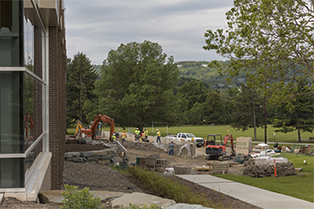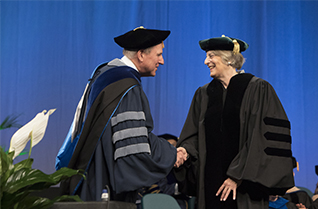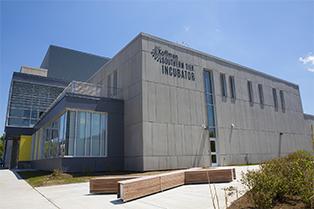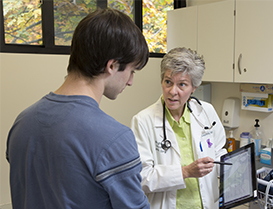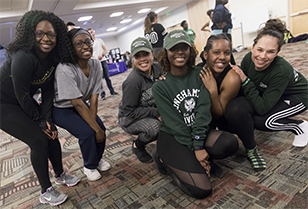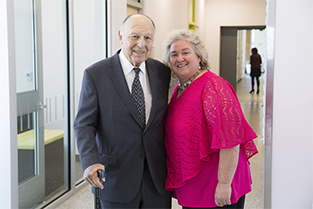Binghamton University President Harvey Stenger's Road Map Quarterly Report - June 30, 2017
The campus is now approaching the dog days of summer, and there is a deceiving quiet on campus. There are fewer students here, and faculty are more likely to be ensconced in their laboratories and libraries, or traveling to conduct field research. The reality is that many of our students are at home – but they’re taking classes online; our faculty are busy doing the work that establishes them as leaders in their disciplines, and our staff are busy preparing for next year’s students. The work goes on, and the excellence that defines Binghamton continues.
Commencement
May saw the University celebrate the graduation of nearly 3,700 students in eight Commencement ceremonies. Of these, approximately 600 were master’s students and 100 received their PhD.
Four honorary doctorates were awarded at the Graduate School ceremony, three of them to Binghamton University alumni. The Doctor of Humane Letters was awarded to Easter Island archaeologist Sergio Rapu Haoa, who spoke at the ceremony. Receiving the Honorary Doctor of Letters degree were award-winning author, playwright and translator Nathan Englander ’91; sportswriter, author and broadcaster Tony Kornheiser ’70; and Geraldine MacDonald ’68, MS ’73, retired senior vice president for AOL.
MacDonald spoke at the Thomas J. Watson School of Engineering and Applied Science ceremony; Kornheiser addressed Sunday morning’s Harpur College ceremony; and Englander spoke at the Harpur College noon ceremony.
We also welcomed Senate Minority Leader Sen. Charles “Chuck” Schumer to two of our ceremonies. Schumer was warmly received at both events and it is good to see that despite how busy he is in Washington, he still makes time to visit Binghamton.
In addition, Thomas J. Porcelli Jr., managing director and chief U.S. economist at RBC Capital Markets received the University Alumni Award at the School of Management’s ceremonies, and Kornheiser, Englander and Amy Hyatt ’78, U.S. Ambassador to Palau, were each recognized as alumni during one of the three Harpur ceremonies. Of course, our graduates were represented as well, with 11 student speakers reflecting on their time at Binghamton.
Graduate School dean
The period following Commencement is often a time of transition, as faculty, staff and administrators retire or move on to other career opportunities, or conversely come to Binghamton to do the same.
This summer we are welcoming Aondover A. Tarhule, a professor of geography and executive associate dean in the College of Atmospheric & Geographic Sciences at the University of Oklahoma, as vice provost and dean of the Graduate School. He will replace Susan Strehle on Aug. 1, 2017.
Tarhule grew up in Nigeria and earned a BS in geography and MS in environmental resources planning at the University of Jos, in Nigeria and completed his MS and PhD in geography at McMaster University in Canada. He’s taught at the University of Jos and completed his post-doc at Queens University in Ontario, and was named assistant professor at the University of Oklahoma, where he’s risen through the ranks to be department chair and executive associate dean.
I want to thank Susan Strehle for her service as the Graduate Schooldean for more than four years, and for her many years of service to the University. She’s been an outstanding dean and colleague who’s left a significant impact on the University in her many roles as a distinguished service professor, Faculty Senate leader and dean.
Campus during summer months
While Commencement brings with it a sense of accomplishment and finality, both for the students and for the faculty and staff, our attention quickly turns to summer tasks and preparing for our next class.
There is a misconception that the campus slows down during the summer, and while there may not be as many faculty and students on campus, everyone seems to stay busy – faculty with research and scholarship activities, and for many students, continued schoolwork in summer courses. Because about two-thirds of our courses are online, many students are able to pursue their studies from home, so there are fewer people on campus.
Summer is the key time for campus infrastructure repairs and construction work — this year, key projects include storm drain, roofing, sidewalk and central heating repairs; renovations to our Science 4 facility; West Gym swimming pool rehabilitation — and even building new ramps for the salamanders on the Connector Road in our Nature Preserve.
We also are moving forward on several large construction projects. These include our Health Sciences Campus in Johnson City. Mechanicals have been roughed-in on our new School of Pharmacy and Pharmaceutical Sciences building, vapor barriers are being installed, and brick work and drywall work is beginning. We are on schedule and on budget for a fall 2018 opening. Across the street from the SOPPS building, asbestos abatement and exterior renovation is ongoing at 48 Corliss Ave., where the Decker School of Nursing will be located. Meanwhile, the Smart Energy Building at the Innovative Technologies Complex is nearing completion, with an opening scheduled for this summer.
Health Sciences Campus
Earlier this year, our School of Pharmacy and Pharmaceutical Sciences (SOPPS) gained pre-candidate status by its accrediting agency, permitting it to begin direct recruiting of students for its inaugural class. The faculty spent the bulk of the semester interviewing prospective students. We received deposits for our full complement of students – around 90 – but we won’t know our exact enrollment until classes begin. Still, we are confident that we will have a class of between 75 and 90 students. The school will hold its inaugural White Coat ceremony on Sept. 9, marking the students’ transition from pre-clinical into clinical studies.
Faculty hiring for the school is on pace. We presently have a faculty of 17.5 FTE (including the dean) and expect to grow in the next two years to around 35 faculty members. We have hired 10 staff members and expect to hire three more next year. Significantly, faculty hiring for the school is having a University-wide impact, raising the total university tenure-track faculty to 641 from 611 (an increase of about 170 since 2012), and lowering our student:tenure-track faculty ratio to 26.5:1. We started at 29.2:1 in 2011. Overall, the FTE student:FTE faculty ratio will be about 19.5:1.
Thus, the new school, and the addition of new faculty members is moving the needle on one of the most important measures of teaching and research quality for colleges and universities.
In fact, faculty research in the SOPPS is already meeting our expectations. Faculty have garnered $2 million in NIH and private funding already and have submitted an additional $14 million in grants.
We see the Health Sciences Campus as an engine, not only for University research and education, but also for local economic development. We are pleased that a private developer is behind a combined retail and housing site just south of the Health Sciences Campus. The developer is renovating two vacant Endicott Johnson properties that will house apartments for nursing and pharmacy school staff and students, while at street-level there will be shops catering to the health science professionals working in and around the campus.
Incubator
The University is also supporting regional economic development through the new Koffman Southern Tier Incubator that had its official opening in early June. On hand were representatives from the governor’s office and Sen. Schumer’s office, as well as NYS Sen. Fred Akshar, Assemblywoman Donna Lupardo, County Executive Jason Garnar and Binghamton Mayor Rich David. (Interestingly, all four of are Binghamton graduates — which shows just how much our graduates value community service as well as the impact that we are having).
This facility, which was one of the key priorities of our Regional Economic Development Council (REDC), has received funding from a number of organizations, including Empire State Development, the Federal Economic Development Administration, Broome County Industrial Development Agency, the Southern Tier Economic Partnership, as well as the REDC.
The incubator itself is a beautiful building, but more impressive than its exterior are the links between the resident companies and the University. Currently, 11 companies are committed to residency, and several of these have links to our campus – with faculty, students and alumni playing a key role in their development. These connections will be ongoing, with University faculty providing technical and business expertise and students serving in research and internship positions. In addition, the fledgling firms will benefit from support services provided by our Small Business Development Center and Trade Adjustment Assistance Center that are located onsite.
The businesses at the facility represent a wide range of industries, including travel/tourism, hospitality/logistics, software development, marketing/branding, security and commercial wireless mesh networks, distribution, transportation and medical devices. The goal of the incubator is to help these startups move quickly to refine their products and move toward commercial viability.
We have an approved accelerator program that will take a cohort of three companies through a six-month process that will guide them from pre-revenue to revenue generating business operation that can be graduated into the incubator or community. And looking toward the future, we have a Clean Energy Incubator Program coming online in the next few months.
Our goal for the next couple of years is to incubate 18 to 22 companies with the hope of graduating out between five or 10 companies per year. We want these companies to succeed quickly and move into production, so they can generate jobs for the region.
Excelsior and budget
In April, New York state passed its budget for fiscal year 2018. The highlight of the budget was the new Excelsior Scholarship program that will phase-in free tuition at New York’s public colleges for families earning up to $125,000.
Our Admissions Office indicates that this year the Excelsior program has had a very moderate impact on our yield rate, in part because the first-–year phase-in of the law only covers those whose families earn between $85,000 and $100,000 – as TAP covers those earning up to $85,000.
Over the long-term, the law should allow Binghamton to raise slightly the quality of our students, as we may attract more applications from students who might otherwise have attended elite private colleges.
At the same time, however, we are concerned about how the law will address such issues as inflationary increases in costs down the line. Our concern is that campuses will need to absorb any gap between what the state funds and the real cost of a student’s education. SUNY and the legislature assure us that the dollars for Excelsior will come to us and that we will be made whole.
The Excelsior program does offer the campus some flexibility in setting tuition for students who do not qualify for the Excelsior program, with a maximum tuition increase of $200 per year for the next four years. Thus, tuition for out-of-state, international and wealthier families will likely increase.
This presents an interesting situation where the campus will have different cohorts of students paying different tuition costs, as one of the provisions of the Excelsior program is that tuition costs are held constant for the time the student is on the scholarship.
One thing that is certain is the program will require significant tracking and reporting to Albany and the Higher Education Services Corporation. The campus will need to certify whether students’ grades are good enough to qualify, how many credit hours students are taking, and later, whether their jobs are in state or not. We are looking carefully at our administrative costs.
One aspect of the Excelsior program that has college and university presidents concerned is the impact that it might have on fundraising, as donors may have the perception that free tuition reduces the need for scholarship support. Of course, one answer to this is that tuition costs are only a small part of the overall cost of attending college — somewhere between half and one-third, with room, board and books adding significantly to expenses. So, scholarship support will continue to be vital to attracting the best students to Binghamton.
At the same time, this does offer an opportunity to think about new areas for support, as these additional state funds free up some donor dollars, particularly as the University begins planning for our next comprehensive gifts campaign.
Certainly, we can look at our other priorities, such as graduate student support, faculty development and facilities enhancement as areas where we might do more. I think these are important questions that we need to look at and I will be working with our advancement team, as well as our alumni and foundation boards to explore our options.
One aspect of the budget that we are viewing favorably is the inclusion of maintenance of effort funds to support operational needs of the campuses, as well as critical maintenance funds totaling $550 million. Of this, $100 million has been set aside by the NYS Senate to fund projects for campuses in their districts. Binghamton will be receiving $6.9 million to fund a research center at our Health Sciences Campus. In addition, the legislature has allocated $154 million to a high-priority fund for necessary maintenance projects, and Binghamton will receive $10.6 million as part of this.
Nearly $300 million in critical maintenance funds will be allocated to SUNY campuses for other projects. Our Physical Facilities Department has a long list of projects that it will be submitting for funding.
Road Map
As the quarter ended, I, along with my senior staff and the members of the Road Map Steering Committee have been busy reviewing proposals developed by members of the Road Map Renewal teams. The process is nearing completion.
The teams submitted their proposals – 37 in all – that were vetted and ranked by the Road Map Steering Committee, with advice from the Faculty Senate, student representatives and Professional Staff Senate. These proposals were then refined and, in some cases, combined with similar ones to reduce the total number to 13, which were again vetted and considered by the steering committee. In the end, the Road Map Steering Committee agreed to move forward on a handful of these.
Our next step will be to put together teams to develop coherent and actionable plans to move these proposals forward, and we will announce the proposals at that time. In general terms, I think that the proposals build on our growing strengths in healthcare and related sciences, as well as new opportunities in disciplines that will shape the world of the future. The campus also will continue to invest in graduate education in order to attract promising advanced students, and will maintain our commitment to attracting and supporting minority students, faculty and staff.
I’m excited to see these initiatives move forward. I want to thank everyone who has been involved in the process for their vision, engagement, and most of all, hard work.
As you can see it’s been a very busy and exciting time at Binghamton, and I think we’re in an excellent position to start the next academic year.
On a final topic, I would be remiss if I didn’t mention the student protest that occurred at the end of the spring semester.
In late April, as the semester wound down, the University administration was considering an effort to address concerns regarding safety in the city of Binghamton. Among the proposals was an initiative to establish a “blue light” emergency call system for parts of the city where many of our students live.
When the blue light proposal was announced by Binghamton Mayor Richard David, between 20 and 30 students raised concerns about the project, citing costs and how the project would be implemented. Among their concerns was a belief the lights were a symptom of a policing strategy that would target economically disadvantaged persons.
I, along with other members of my administration, agreed to reconsider the blue light proposal, while remaining committed to finding some way to honor our desire to improve safety in the city. Nonetheless, the students occupied the lobby of the Couper Administration Building and remained in the building for over two weeks. While the students were in the building, we relocated staff to other offices on campus.
As finals and the end of the semester approached, the students eventually left the building, and staff returned to the building on Wednesday, May 17.
Clearly, student protests are a feature of modern universities – and this is particularly true in times as politically contentious as we are in now.
At the same time, we’ve also moved to address some of the students’ concerns with a plan to create a new Town/Gown Advisory Board to be launched this fall that will Identify mutual concerns and recommend thoughtful responses to those concerns.
We also have appointed Randall Edouard as the new assistant vice president for student affairs, focusing on the needs of off-campus students and town/gown relations. He most recently was assistant vice provost and director of admissions and enrollment. Prior to that he was the director of our Educational Opportunity Program and I think he will do well in developing links between the campus and the community.
So, as you can tell it, was a busy quarter.
Have a great the rest of the summer!
Sincerely,

Harvey G. Stenger

